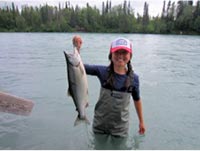
Name: Lindsay Martin
Education: B.S. in Natural Sciences with a Concentration in Biological Education at Colorado State University (during this time she also worked as an undergraduate in the Crab Lab), currently working on M.S. at CSU.
Hometown: Seoul, Korea
Career goal: After graduating from CSU Lindsay taught science at an alternative high school for five years before returning to the University to complete her master’s in science. Lindsay tells me that she believes in taking “the best opportunity available” to her, in hopes that she will “appeal to more jobs” and “become more diverse” as a person. She hopes to take her experiences and knowledge she’s gained from the lab, along with her master’s degree, and some day teach at a collegiate level.
Favorite Memory: Lindsay views her experience in the Crab Lab as her “first taste of independent research.” With this experience she embraces the freedoms of pursuing scientific questions through designing and controlling her own experiments, and faces the challenges of troubleshooting those experiments. Lindsay expresses that she “thinks every science major should work in a lab for at least a year, to get a taste of what science outside the classroom is like.”
Project: Exploring Next Generation Sequencing technology and comparative studies of the Y-organ in different stages of the molt cycle in the blackback land crab (Gecarcinus lateralis).
The Main Information Center
Lindsay’s research explores the organ in the land crab that is the main control center for molting; this organ is known as the Y-organ. The Y-organ is intensely investigated in Dr. Mykles’ lab, mainly because it tells a lot about the mechanisms of molting. Considering all that is controlled by this one organ, it is safe to say that the Y-organ is a wealth of information–that is, if we can somehow access the information it holds.
The “information” of which we speak is cellular data that instructs all cells in the organism to function. Every single cell, in every tissue of the crab, contains this essential information in the form of DNA. The DNA is like an instruction manual for the organism; it tells which genes when and how to act in each cellular process. How convenient it is to know where this information is found. Now the question becomes: how do we access it?
The Future of Science is Now
Modern technology provides scientists with the tools needed to sequence a gene transcriptome. A gene transcriptome is all of the genetic information found in the cell at a given time. Sequencing a genome would basically be like putting a crab into a very sophisticated printer, and it spitting out the animal’s entire instruction manual for us to read.
Acquiring a gene transcriptome is essentially what Lindsay is doing for one of her projects. The project involves dissecting out Y-organ samples from crabs each in different stages of the molt cycle. The DNA from each tissue is isolated, and then sent off to the sophisticated printer to be sequenced. When the results come back, they are in the form of about 500 million readings that need to be analyzed and interpreted. This leaves the researchers facing “a logistical nightmare”, as Lindsay puts it.
Lindsay’s current challenge is sifting through the overwhelming amount of gene sequences, trimming out the most accurate and significant portions, and lining them all up in a readable string of information. Computer programs are used to interpret the full gene sequence, finding the most useful parts of the sequence for researchers to analyze. This process is the basis for most of the new discoveries occurring in the Crab Lab as well as in countless research labs around the globe.
YO
How Lindsay is exploring the function of the Y-organ is directly related to the sequencing process described above. Specifically, she is taking Y-organ samples from crabs in the early premolt, mid premolt, and late premolt stages, and sequencing these transcriptomes. With the transcriptome technology she can analyze each of the gene sequences from the Y-organs at various stages, looking specifically at which genes are expressed in each stage. In this way she can compare the expression of genes in the same organs at various stages of the molting cycle, thus gaining a better understanding of how the cycle works.
Another angle she is using to investigate the Y organ’s function is with a chemical called rhapomyacin. This particular chemical is injected into the crab in the laboratory to inhibit the animal from molting. In other words, the presence of the chemical causes the growth and molting of the crab to cease. Lindsay uses the same analysis process described above to compare the activities of a normal Y-organ and a Y-organ under the influence of rhapomyacin. By comparing the two she can observe differences in the gene expression of the organs, thus investigating the effects of rhapomyacin on the mechanisms of molting.
Pulling it All Together
Lindsay describes the transcriptome sequencing technology to be “very powerful”, for it allows scientists to see more information than has ever been seen before. Now that this technology is affordable and accessible to the Crab Lab, it is very interesting and exciting to see what will be discovered with these new methods. “The more you know about a subject, the more you find you don’t know,” Lindsay articulates. The researchers have hypotheses about how the processes in the land crab work; what they find in the transcriptome can either validate those hypotheses or present new information that will have to be factored into the equation. Lindsay very realistically states: “we may find that our whole conception of the process could be wrong”.
